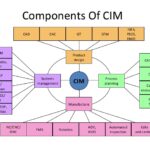Computer Integrated Manufacturing (CIM) is considered a natural evolution of the technology of CAD/CAM which by itself evolved by the integration of CAD and CAM. Massachusetts Institute of Technology (MIT, USA) is credited with pioneering the development in both CAD and CAM. The need to meet the design and manufacturing requirements of aerospace industries after the Second World War necessitated the development these technologies. The manufacturing technology available during late 40’s and early 50’s could not meet the design and manufacturing challenges arising out of the need to develop sophisticated aircraft and satellite launch vehicles. This prompted the US Air Force to approach MIT to develop suitable control systems, drives and programming techniques for machine tools using electronic control.
The first major innovation in machine control is the Numerical Control (NC), demonstrated at MIT in 1952. Early Numerical Control Systems were all basically hardwired systems, since these were built with discrete systems or with later first generation integrated chips. Early NC machines used paper tape as an input medium. Every NC machine was fitted with a tape reader to read paper tape and transfer the program to the memory of the machine tool block by block. Mainframe computers were used to control a group of NC machines by mid-60’s. This arrangement was then called Direct Numerical Control (DNC) as the computer bypassed the tape reader to transfer the program data to the machine controller. By late 60’s mini computers were being commonly used to control NC machines. At this stage NC became truly soft wired with the facilities of mass program storage, offline editing and software logic control and processing. This development is called Computer Numerical Control (CNC). Since 70’s, numerical controllers are being designed around microprocessors, resulting in compact CNC systems. A further development to this technology is the distributed numerical control (also called DNC) in which processing of NC program is carried out in different computers operating at different hierarchical levels – typically from mainframe host computers to plant computers to the machine controller. Today the CNC systems are built around powerful 32 bit and 64-bit microprocessors. PC based systems are also becoming increasingly popular.
Manufacturing engineers also started using computers for such tasks like inventory control, demand forecasting, production planning and control etc. CNC technology was adapted in the development of co-ordinate measuring machine’s (CMMs) which automated inspection. Robots were introduced to automate several tasks like machine loading, materials handling, welding, painting and assembly. All these developments led to the evolution of flexible manufacturing cells and flexible manufacturing systems in late 70’s.
Evolution of Computer Aided Design (CAD), on the other hand was to cater to the geometric modelling needs of automobile and aeronautical industries. The developments in computers, design workstations, graphic cards, display devices and graphic input and output devices during the last ten years have been phenomenal. This coupled with the development of operating system with graphic user interfaces and powerful interactive (user friendly) software packages for modelling, drafting, analysis and optimization provides the necessary tools to automate the design process.
CAD in fact owes its development to the APT language project at MIT in early 50’s. Several clones of APT were introduced in 80’s to automatically develop NC codes from the geometric model of the component. Now, one can model, draft, analyse, simulate, modify, optimize and create the NC code to manufacture a component and simulate the machining operation sitting at a computer workstation.
If we review the manufacturing scenario during 80’s we will find that the manufacturing is characterized by a few islands of automation. In the case of design, the task is well automated. In the case of manufacture, CNC machines, DNC systems, FMC, FMS etc provide tightly controlled automation systems. Similarly computer control has been implemented in several areas like manufacturing resource planning, accounting, sales, marketing and purchase. Yet the full potential of computerization could not be obtained unless all the segments of manufacturing are integrated, permitting the transfer of data across various functional modules. This realization led to the concept of computer integrated manufacturing. Thus the implementation of CIM required the development of whole lot of computer technologies related to hardware and software.


